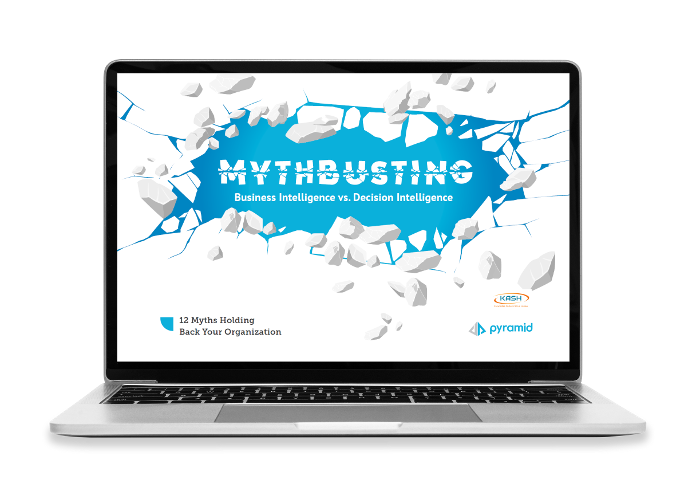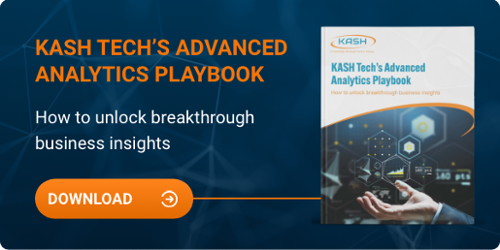Contents
Introduction
For decades, BI and analytics tools provided organizations with reports, dashboards, and visualizations against data warehouses or in-memory data stores. But in most organizations, business people — from the C-Suite to the frontline — remain highly dependent on technical teams for their reports and dashboards. They rely on a wide range of systems, integrations, workarounds, and “key persons” to access the data they need to create reports and dashboards. The process is complicated and time-consuming and only serves to make intelligent decision-making more difficult.
Why does traditional BI fail to deliver value in the world we operate in today? And why do organizations continue to invest in multiple fragmented tools that require specialized technical skills that only make things worse? We believe it boils down to several myths, or widely accepted “truths,” that are born from the limitations of today’s BI tools. These myths aren’t wrong as much as they are outdated. Because there is a better way. Today we have decision intelligence, what’s next in analytics. Decision intelligence turns many critical limitations of BI and analytics on its head.
The old way = Static, outdated reports and dashboards that require requests for data extracts and technical skills to get different analytical views, restricting decision-making.
The new way = Insights for everyone and a thriving data-driven culture.
In this guide, we cover some of the most widely held beliefs about data and analytics today. We’ll show you how, with a new approach, you can move past these limiting beliefs to take your analytics to the next level and get on a faster path to growing revenue, boosting productivity, saving time and money, identifying new revenue streams, and reducing complexity and risk.
Data Myths
1. All your data must be in one place to analyze it and get the answers you need.
2. You can’t do analytics on large-scale data sets.
3. An analytics dashboard can only display one source of data.
4. Data must be replicated and it’s not possible to apply security automatically.
People Myths
1. It’s best to treat your IT team as a service that builds reports on request.
2. You need to hire many data scientists to get more value from your data investments.
3. Adoption of data-driven decision-making will never grow beyond people with technical skills.
4. AI is just a dream, and something you only see in the movies.
Analytics Myths
1. You cannot meet all your analytical needs with a single tool.
2. All analytical tools deliver the same capabilities and value.
3. Significant impacts occur when your data sources change.
4. To enable a data-driven culture, you must take a departmental approach to analytics.
Download Your Personal
Copy of the eBook

Fill out the form to receive your copy of the eBook.
Download the eBook
Business Intelligence (BI) vs.
Decision Intelligence
What is Business Intelligence (BI)?
Business Intelligence (BI) and analytics pertains to various tools, programs, technologies, and practices used to collect, integrate, measure, analyze, and present raw data to generate insightful, valuable, and actionable business information. Organizations use BI and analytics tools to understand their data in order to make better decisions.
Whether centrally administered or decentralized, BI and analytics tools have been adopted broadly at most mid-sized and large organizations and are considered effective tools in all kinds of businesses.

The Promises of BI and Analytics
- Gather Data from internal and external sources.
- Prepare data for analysis.
- Design and run inquiries against the data.
- Produce reports, dashboards, and data visualizations.
What is Decision Intelligence?
Business Intelligence (BI) and analytics pertains to various tools, programs, technologies, and practices used to collect, integrate, measure, analyze, and present raw data to generate insightful, valuable, and actionable business information. Organizations use BI and analytics tools to understand their data in order to make better decisions.
Whether centrally administered or decentralized, BI and analytics tools have been adopted broadly at most mid-sized and large organizations and are considered effective tools in all kinds of businesses.

The Promises of Decision Intelligence
- Create more compelling and relevant data stories.
- Don’t delay insights because IT has to move data into a central repository.
- Reduce the backlog of requests for reports, dashboards, and data extracts.
- Accelerate adoption of insight-led decisions by everyone from the C-suite to the front line by delivering tailored access to the insights needed to answer questions and take action.
- Meet requests for capabilities from the simple to the sophisticated, empowering anyone from a data novice to a data scientist to be self-sufficient.
Data Myths
Data is exploding. The volume of data generated, consumed, copied, and stored is projected to reach more than 180 zettabytes by 2025. In 2020, the total amount of data generated and consumed was 64.2 zettabytes. (Source: Statista)
The tremendous rate of growth in data can either be a hindrance or a help to organizations looking to gain a competitive advantage from their data and analytics investments. Many believe the only way to deal with the volume of data is to spend endless amounts of time wrangling data from disparate sources, replicating it, bringing it into a single place, and parsing it into bite-sized data sets so it can be analyzed.
Instead, organizations must be able to instantly connect to any data source directly, query, and blend any amount of data. But is it even possible? This section breaks down commonly held beliefs about data management and shows you how to use any data within your organization for better decision-making.
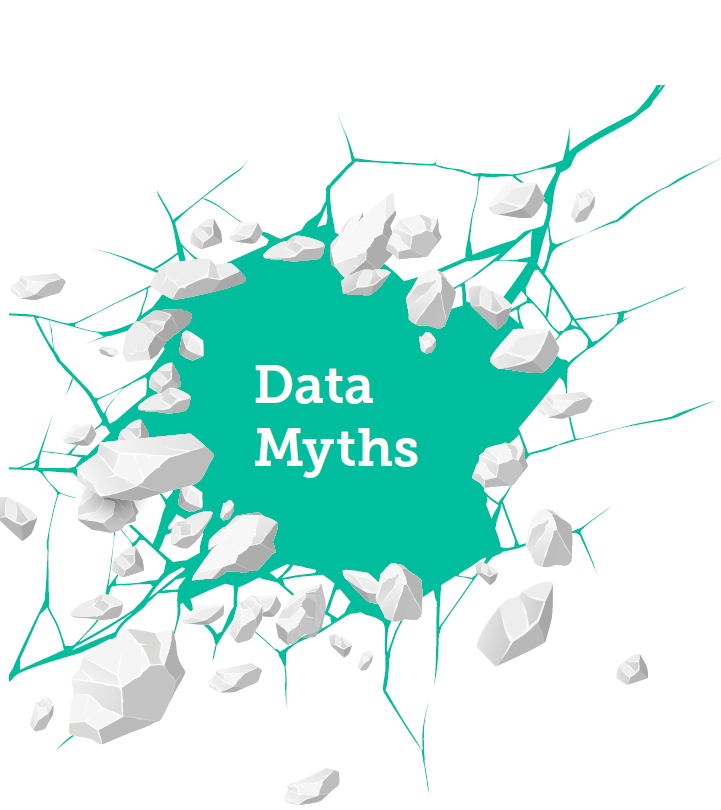
Myth #1:
All your data must be in one place to analyze it and get the answers you need.
What's behind this myth?
The incredible growth in the volume of data an organization collects is met by an equally astounding number of data sources. According to a recent survey, companies draw from an average of 400 different data sources to feed their BI and analytics tools, and 20% of the organizations surveyed reported having
1,000 or more data sources.
A traditional approach to data analytics and BI suggests an organization must bring all of this data together in one place to analyze it. But how? Cloud data warehouses are the approach many organizations use, but time-consuming data preparation, maintenance costs, and data analysis limitations are holding them back.
 Companies draw from an average of 400 different data sources to feed their BI and analytics.
Companies draw from an average of 400 different data sources to feed their BI and analytics.
Why do people believe this?
- Typical BI tools require data to be brought into a single standardized format to ensure consistency.
- Consolidating data into a single place is the only way to use it to enable faster, better decision-making.
- Having data in one place is the only way to see trends and compare data across the enterprise.
Truth:
Leave your data where it is.
While there will always be a role for data warehouses featuring highly curated data, volumes are growing exponentially. It is becoming difficult — if not impossible — to keep up with the near-constant requirement to prepare the data for analytics consumption.
For your organization to truly get the most out of its data, regardless of how complex your environment is, leave the data where it is and bring your analytics platform to your data instead. To achieve this, look for a platform that can directly query the data, no matter where it is.
Myth #2:
You can’t do analytics on large-scale data sets.
What's behind this myth?
Organizations must capitalize on their explosive data growth. They need an analytics solution capable of handling a large volume of data to do so. But organizations believe they must accept the limitations of BI and analytics tools that rely on in-memory engines to analyze it. These engines are simply not built to handle large data sets. So organizations are instead trained to break up their data and feed it in simplified, bite-sized pieces to the BI engine. Data is extracted and moved elsewhere, whether to Excel or another tool, for transformation before being re-introduced to the BI tool.
 Enterprises will generate and manage 60% of the 163 zettabytes of data by 2025.
Enterprises will generate and manage 60% of the 163 zettabytes of data by 2025.
Why do people believe this?
- Most analytics tools are limited to handling data they can access directly from a single data source or data that has been extracted from its original source and blended to create a single data set.
- Analytics tools crash or run slowly when working with large data sets.
- Most analytics tools have data upload limits that require people to break up
large-scale data sets.
Truth:
You can do analytics in place.
While in-memory engines can handle smaller, less complicated data sets, they can’t keep up with larger ones. So why use in-memory engines? You can do analytics on large data sets with the right type of analytics engine: one that can directly query the data where it is.
Myth #3:
An analytics dashboard can only display one source of data.
What's behind this myth?
In an ideal world, decision-makers across an organization could access a dashboard of all data to gain a true 360-degree look at the trends and factors driving their decision-making. In reality, people have come to expect dashboards that can only display one source of data. So instead of a single dashboard, organizations end up with dozens of dashboard views of all different data sources making analysis and insight difficult to come by.
While this limitation is widely accepted as accurate, what’s also true is that answers to complex questions often require more information from more sources. A common workaround is to extract data from core systems and bring it together in a single dashboard. However, this introduces data latency and replication risks.
 "Reports and dashboards are still the most common types of analytics with nearly all organizations (97% and 96%, respectively) indicating they are important or use them currently."
"Reports and dashboards are still the most common types of analytics with nearly all organizations (97% and 96%, respectively) indicating they are important or use them currently."
Ventana Research Analytics and Data Benchmark Research, 2022
Why do people believe this?
- Most BI tools simply cannot integrate data from multiple sources into a single dashboard view.
Truth:
You can integrate disparate data into a single dashboard.
Data from one source alone is not always enough. Insights come when data intersect, revealing new perspectives. To see beyond the obvious, you must be able to integrate data from multiple sources, wherever that data resides — Amazon Redshift, SQL Server, Excel, wherever.
The truth is, it’s possible to integrate governed data into a single dashboard with the right platform. With the right decision intelligence platform, any person can display disparate data sources they have managed access to on a dashboard. And better yet, be capable of filtering, slicing, and dicing across that data without duplicating or extracting it to a separate location. That’s where you get unexpected answers.
Myth #4:
Data must be replicated and it’s not possible to apply security automatically.
What's behind this myth?
Many BI tools force people to replicate data from source locations into a data silo or warehouse before they can analyze it. The idea is to copy data from various enterprise sources, clean it, and have a separate, controlled environment to store the data where it can be accessed by the BI tool. In addition to security that is implemented on the data warehouse, some analysts find themselves building content multiple times to go against different data sets to restrict what access is available to the end-user.
Replicating the data preserves the structure of the original source but adds extra steps and complexity to the process as organizations need resources and procedures to maintain the data’s consistency. Is this necessary? Is this smart?
 "Data preprocessing such as cleansing and formatting it for analysis is time-consuming. Some estimates suggest that this can account for 80% of the effort in data analysis projects."
"Data preprocessing such as cleansing and formatting it for analysis is time-consuming. Some estimates suggest that this can account for 80% of the effort in data analysis projects."
 “Analysts spend the bulk of their time on manual tasks such as preparing data for analysis (47%) and checking quality and consistency (45%) in the data rather than doing actual analysis.”
“Analysts spend the bulk of their time on manual tasks such as preparing data for analysis (47%) and checking quality and consistency (45%) in the data rather than doing actual analysis.”
David Menninger, Ventana Research
Why do people believe this?
- Organizations are told that replicating data keeps it consistent, reliable, and up to date.
- Typical analytics tools are built to pull from a data warehouse instead of straight from the data source, claiming this improves the speed and efficiency of the data analysis.
- Organizations are encouraged to avoid working directly with source data to preserve it.
Truth:
There’s no need to replicate data for decision intelligence.
Data replication is a widely accepted strategy for disaster recovery, but when it comes to analytics, it increases risk. Replicating your data and moving it to another location loses its inherent security, and, depending on the way the data is shared (extracted into intermediate files and shared via email or other insecure means, etc.), can inadvertently introduce additional downstream security concerns (e.g., data getting into the wrong hands). Plus, you risk creating copies of the data that conflict with the source data (data silos). Data latency is another concern: the moment it’s extracted from the source, it’s no
longer up to date. Leave the data where it is and avoid the unneeded chaos.
People Myths
The promise of BI and analytics conjures up images of business leaders and managers peering into rich dashboards, orchestrating data-driven strategies, and driving innovation. In reality, many organizations are surprised to learn that usage
rates drop surprisingly low after investing in a months-long analytics project and experiencing the initial excitement. That’s because it’s not enough to offer “self-service business intelligence.” Systems are still too fragmented, causing mistrust in data and chaos in decision-making.
There are many reasons why self-service analytics and BI technology is falling short, but there are becoming fewer reasons to continue living with the shortcomings. It turns out, with DI, organizations can benefit from a no-code, point-and-click browser experience that empowers any person, from the novice to the data scientist, to make data-driven decisions.
In this section, we break down commonly held beliefs about data and analytics accessibility and look at how today’s AI-driven analytics solutions can put data into the hands of decision-makers across the organization.
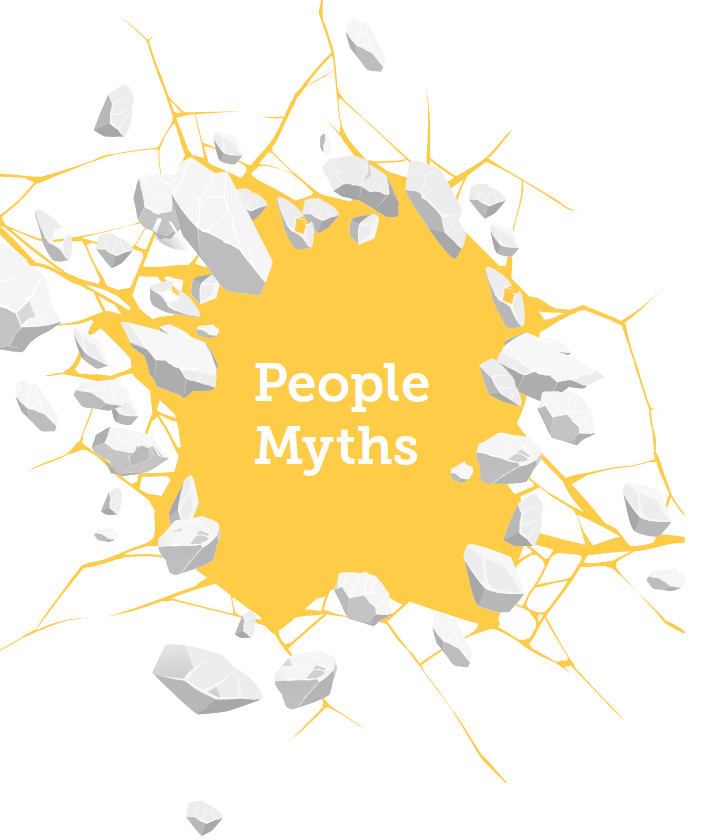
Myth #5:
It’s best to treat your IT team as a service that builds reports on request.
What's behind this myth?
When adding new technologies to an organization’s stack, the IT team has traditionally played a critical role in evaluating and selecting new tools. This role often extends into the actual use of the technology at hand as IT helps implement, integrate, and train staff on the new tool.
When it comes to business intelligence, organizations have no shortage of BI tools at their disposal, but many find people lack the skills to leverage these tools for basic reporting, let alone make strategic decisions with them. What often happens is the IT team, which was responsible for implementing the BI tool in the first place, becomes the bottleneck, and business people rely upon them to pull reports and make changes to reports on a regular basis. This routine practice delays the availability of timely data and disempowers people from embracing and fully leveraging their organization’s data.
 67% of managers and executives are not comfortable accessing or using data from their analytics tools.
67% of managers and executives are not comfortable accessing or using data from their analytics tools.
Why do people believe this?
- IT teams use BI and reporting tools the most, and many people are content to
stay with the status quo. - The only way to standardize reporting is to centralize the function, and IT is a
natural choice for the job. - Traditional BI requires IT to pull in-house data to generate reports because the data is not readily available, and the systems are not in place to disperse it.
Truth:
Analytics can live where decisions are made.
Your IT team brings significant value as administrators and managers of the data and analytics stack. They are in charge of balancing data security and access and optimizing infrastructure investments to manage costs. Why distract them from their core mission by having them spend countless hours manually producing and reproducing reports? The creation and upkeep of the reports should be with the business, the place where decisions are made. The right type of analytics platform allows business people to be self-sufficient, accessing and preparing
data for analysis independently, without having to wait for IT.
Myth #6:
You need to hire many data scientists to get more value from your data investments.
What's behind this myth?
Data science is an exploding field, fueled by organizations seeking actionable insights from the vast amount of disparate data they have collected. Hiring data scientists — those trained to process, model, analyze, and extract insights from this data — is often viewed as a critical first step. However, many organizations aren’t prepared to accommodate the specialized environments
they require. What’s more, organizations shouldn’t expect data scientists to use buiness intelligence tools. So, despite an urgent need for more advanced capabilities, hiring data scientists may only make it more difficult to reap the benefits of data investments.
 The U.S. Bureau of Labor Statistics predicts the data
The U.S. Bureau of Labor Statistics predicts the data
science field will grow about 28% through 2026.
 90% of respondents say data-driven decision-making is a growing priority.
90% of respondents say data-driven decision-making is a growing priority.
Why do people believe this?
- The challenges of integrating exploding data stores are so great, people believe the only way to deal with the challenge is to hire data scientists.
- People feel pressure to make decisions faster and think that data scientists can more quickly make sense of their data.
- Most tools are too technical to be used by managers and leaders with traditional skill sets.
- People believe data is too complex to be analyzed and interpreted by people who lack specific training.
Truth:
Citizen data scientists are here.
While data scientists will surely add value to your organization in the long run, gone are the days when data science was reserved exclusively for data scientists.
Now an entire generation of business workers is expected to use data in their daily roles. These citizen data scientists, armed with domain knowledge and a strong desire to use data to drive their decisions, can in some cases prevent the need to hire pedigreed data scientists. In many cases, they can be just as effective as data scientists, as long as they have access to a solid foundation of data and
analytics capabilities.
Myth #7:
Adoption of data-driven decision-making will never grow beyond people with technical skills.
What's behind this myth?
Despite the powerful potential and colossal investments made in business intelligence tools for self-service analytics, the actual usage of these tools is far less than anticipated. What’s more, most available business data — more than 80% — is not used to make decisions (even as it has grown exponentially in recent years). And employees — again, more than 80% —don’t have access to analytics.
Common challenges impacting the scalability and adoption of BI tools include tools that are simply too challenging and time-consuming to use and an overall lack of appropriate analytical skills required to effectively use the organization’s chosen technologies. As such, it is well-accepted that only a select few within an organization actually “own” the business intelligence function.
 “The average adoption rate of business intelligence (BI) among employees in mid to large companies is 15%.”
“The average adoption rate of business intelligence (BI) among employees in mid to large companies is 15%.”
Why do people believe this?
- People believe BI tools are too complex and time-consuming for everyone to learn
and use. - People worry that the widespread use of existing BI tools will cause data to be
misused or misinterpreted. - There is a lack of resources to train decision-makers to use existing tools.
Truth:
The right platform will scale.
Yes, the reports of low levels of analytics adoption are accurate. But that’s only for organizations that are using the wrong tools! Widespread adoption of analytics and BI is indeed possible on a platform. By centralizing data access in a governed location, and by giving anyone — regardless of skill —analytics experiences that adapt to their needs, an organization can scale analytics beyond the few to the many. Decision intelligence can be extended to all people in the organization to
make better decisions in their unique roles.
Myth #8:
AI is just a dream, and something you only see
in the movies.
What's behind this myth?
AI is defined as the development of computer systems that can handle tasks previously performed only by humans. While many technologies claim to be AI-driven, the reality experienced by many people is that there is still much to be desired when replacing human actions and thinking. People still find themselves structuring their data, analyzing data, extracting insights, and making decisions from scratch. Where’s the AI to truly support decision-making? As far as managers and executives can see, it’s all just a dream.
 More than 95% of enterprises consider AI technology to be important to their digital transformation efforts.
More than 95% of enterprises consider AI technology to be important to their digital transformation efforts.
451’s “Voice of the Enterprise: AI & Machine Learning Use Cases 2021”
 “By 2025, 9 in 10 analytics processes will be enhanced by artificial intelligence and machine learning to streamline operations and increase the value that can be derived from data.”
“By 2025, 9 in 10 analytics processes will be enhanced by artificial intelligence and machine learning to streamline operations and increase the value that can be derived from data.”
David Menninger, Ventana Research
Why do people believe this?
- Business intelligence tools don’t deliver clear insights to drive fast and informed decision-making.
- There is still a lot of human interaction required to extract and organize data for use within BI tools.
- BI tools are still too complex for many executives and managers to use, requiring
technical know-how to produce meaningful analytics.
Truth:
The right AI-driven capabilities will support everyday decisions.
The knock against AI is that it can’t provide real value to day-to-day decisions. It’s a myth! The trick is to expose AI in ways that support common business challenges — not sit apart from them. With the right platform, AI and intelligent tools can help even the most non-technical people in your organization be more productive and gain business insights. How? AI can be brought into everyday analytics scenarios with the right software.
Analytics Myths
So far, we’ve covered some of the top business intelligence myths related to data and people. But one more category of myths gets to the core differences between business intelligence and decision intelligence and underscores how organizations are being held back by current tools. The next four myths relate to the analytics tools organizations use to retrieve and combine data for analysis.
A recent FinancesOnline report found improved efficiency and productivity (63%) and faster, more effective decision-making (57%) are the top benefits companies say they get from using analytics. Shouldn’t these numbers be higher? It turns out among the top reasons organizations say they are held back from more effective use of analytics are data privacy and security concerns (49%), limited access to data (33%), lack of
training (29%), and the feeling that analytics solutions are not user-friendly (28%).
The myths we dispel in this section will reveal the possibility of combining data prep, business analytics, and data science into a single unified platform that would allow for sophisticated analytics and data science without writing a line of code — with governance and security built-in.
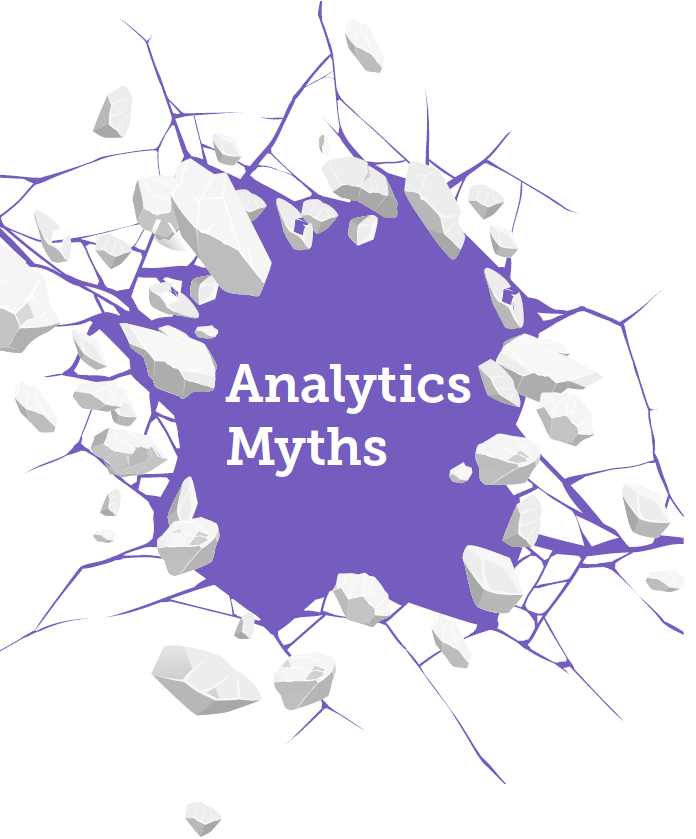
Myth #9:
You cannot meet all your analytical needs in a single tool.
What's behind this myth?
It’s only normal to think common practices are best practices. In the case of analytics tools, it’s common for organizations to take a department-by-department approach to analytics. One tool for finance, another for marketing, another for sales. One for data prep, one for data science, one for reporting. Before you know it, each department or function pulls data into its own tools, believing that this compartmentalized approach is best.
This behavior is predicated on the belief that no single analytics tool can possibly serve all organizational needs. On average, organizations own four or more different analytics tools, a recipe for isolated decision-making, incomplete and inaccurate data, and ever-diminishing adoption.
 25% of organizations use 10 or more BI platforms, 61% of organizations use four or more, and 86% of organizations use two or more.”
25% of organizations use 10 or more BI platforms, 61% of organizations use four or more, and 86% of organizations use two or more.”
Why do people believe this?
- People in different departments and functions (sales, finance, product) require their own specialized analytics tools.
- For many, this is the way it’s always been done and therefore a default “best practice.”
- Analytics tools lack the all-in-one functionality necessary to combine data prep, data science, and reporting.
Truth:
A decision intelligence platform provides complete capabilities to meet your needs.
While a departmentalized, best-of-breed approach is an effective strategy in some
areas of a modern business, analytics is an exception. In fact, trust in data erodes when you have several data prep tools, standalone data science workbenches, and numerous analytics and reporting tools for different people in different departments. With a decision intelligence platform — which is purpose-built to combine all three capabilities and functions in one single, unified solution — you don’t need all those separate tools. What’s more, with decision intelligence, you can get a no-code point-and-click experience where everyone, from data novices to data scientists, can get value from the data analytics experience.
Myth #10:
All analytical tools deliver the same capabilities and value.
What's behind this myth?
The ability to capitalize on data and analytics is a fundamental characteristic of breakaway organizations. Those that can unlock the right combination of data and analytics to deliver tailored decision-making capabilities — at scale — will rise above the rest. On its face, it’s a straightforward formula: provide people with a BI tool that allows them to readily retrieve the data they need to generate insights.
Look at the mission or vision statement of just about any self-professed BI and analytics tool, and you’ll see remarkable similarities. “Help people see and understand data.” “Move faster, work smarter, and lead the way forward with an end-to-end solution for getting value out of data.” To the casual observer, all analytical tools provide the same value — they’re nothing more than a commodity. Simply pick the most well-known or hyped vendor, connect your data, and you’re off to the races.
 “Across industries, we see organizations investing heavily to integrate analytics throughout their entire business in an effort to capture a portion of the $9.5 trillion to $15.4 trillion of value that the McKinsey Global Institute estimates advanced analytics can enable across industries globally.”
“Across industries, we see organizations investing heavily to integrate analytics throughout their entire business in an effort to capture a portion of the $9.5 trillion to $15.4 trillion of value that the McKinsey Global Institute estimates advanced analytics can enable across industries globally.”
Why do people believe this?
- With so many analytics and BI vendors on the market, it’s hard to discern the true differentiation from one tool to another.
- People figure the vendor they trust for another important aspect of their business must also be the best analytics vendor.
Truth:
Tools are the same; a decision intelligence platform delivers insights for everyone.
Data analytics is an exciting field, filled with innovation, yet it’s difficult to discern true vendor differentiation. But there are clear differences when you compare tools versus platforms. BI and analytics tools solve departmental needs and are designed primarily for users with technical skills. A platform enables broad but governed data access, promotes analytics adoption with tailored capabilities designed for different people, and provides ready access to the data needed to make decisions. A decision intelligence platform takes it even further: adding data science capabilities and integrating AI guidance and automation to quickly show different analytical perspectives. A decision intelligence platform is anything but a commodity: it’s purpose-built to help an organization grow revenue, reduce costs,
and boost productivity.
Myth #11:
Significant impacts occur when your data sources change.
What's behind this myth?
Data strategies are in a constant state of flux. When organizations migrate data from an on-premises database to the cloud (AWS Redshift, Azure, GCP, Snowflake, etc.) to save on infrastructure costs, or when a vendor updates an application that changes a backend data structure, the downstream analytics models, visualizations, and dashboards are often the first to break. With typical BI tools, it’s common to invest significant time and resources manually rebuilding all the views.
While many data and analytics leaders prepare for these changes ahead of time, sometimes little thought is given to the true impacts on the business. Either way analytics professionals expect to commit significant time and resources. Why? Most traditional BI and analytics tools were never designed with flexibility in mind. They were designed for individuals or departments, not organization-wide needs. When big changes come, the impact on analytics and reporting is time-consuming and expensive.
“The first generation of BI tools was designed around the needs of corporate data warehouses, and they remain a vital part of the business intelligence landscape,” Forbes reported in March 2021. “But with the growth of unstructured data in multiple different sources... a human being can simply no longer grasp the amount of data that organizations manage.”
 “53% of companies have an on-premises data warehouse and 36% have one in the cloud.
“53% of companies have an on-premises data warehouse and 36% have one in the cloud.
Why do people believe this?
- With data strategies changing all the time, organizations have come to expect significant impacts to the business (and downstream analytical content such as dashboards and reports) as a fact of life.
- Most BI and analytics tools were designed to solve individual or departmental problems, not organization-wide data infrastructure needs.
Truth:
When you separate data from your analytics with a semantic layer, you can reduce the impact of IT and data changes on your business.
When it comes to your data and analytics, change doesn’t have to be hard. Avoid using analytical tools that weren’t designed with enterprise-wide needs — and inevitable changes — in mind. When you separate data from analytics from the data via a virtual semantic layer — a key capability of a decision intelligence platform — you can insulate your organization from broad changes to the data strategy. Using functionality purpose-built to accommodate and manage change, the downstream impacts to business reporting can be minimized — and an organization is free to pursue a holistic data strategy that focuses on the needs of the whole enterprise.
Myth #12:
To enable a data-driven culture, you must take a departmental approach to analytics.
What's behind this myth?
Within many organizations, it’s common to see different people using different departmental analytics tools. While a bottom-up approach makes analytics and BI tools widespread, the transformational benefits are rarely seen. Tools require technical skills, resulting in backlogs of requests and inconsistent reporting. When organizations continually add new tools designed for specific people and use cases, it exacerbates the growing problem of tool sprawl.
What’s behind the adoption of so many different analytics tools is the belief that people within different parts of the business each have specialized needs and requirements. Departmental needs are unique both in terms of their data and reporting requirements and the access to the technical resources necessary to use the technology. As a result, adoption remains low across the organization and the goal of being “data-driven” continues to be elusive.
 “Less than 20% of people who need access to BI/Analytics tools have access and the analytics experience is difficult to scale because tools are difficult to use.”
“Less than 20% of people who need access to BI/Analytics tools have access and the analytics experience is difficult to scale because tools are difficult to use.”
McKinsey & Co
Why do people believe this?
- Everyone needs analytics, but people are led to believe analytics is not for everyone
to use. - Organizations often lack a strategic, organization-wide approach to BI and analytics. People in departments make decisions about the analytic capabilities they need and see no reason to approach this differently.
Truth:
A platform can serve all needs, from the simple to the sophisticated.
If you want to quickly enable a data-driven culture, you need to take a more strategic, organization-wide approach to analytics. The truth is everyone needs insights, not just the expert few, regardless of where they sit within the organization. While each type of person has individualized analytics needs, they shouldn’t rely on point solutions with limited scope and enterprise reach. By taking a strategic approach to analytics and choosing a unified platform purpose-built for people with different needs, organizations can reduce reporting backlogs, produce consistent reporting, and extend analytics across the organization. This helps organizations grow revenue and identify new revenue streams; reduce cost, complexity, and risk; and boost productivity by saving time and money.
Download Your Personal
Copy of the eBook
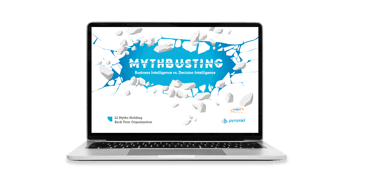
Fill out the form to receive your copy of the eBook.
Download the eBook
A Purpose-Built Platform
Pyramid is what’s next in analytics. Our unified decision intelligence platform delivers insights for everyone to make faster, more informed decisions. It provides direct access to any data, enables governed self-service for any person, and serves any analytics need in a no-code environment. The Pyramid Decision Intelligence Platform uniquely combines Data Prep, Business Analytics, and Data Science in a single environment with AI guidance, reducing cost and complexity while accelerating growth and innovation. Flexible deployment options include on-premises, public, private and hybrid cloud, and multi-cloud environments.
- Provides an intuitive, consistent browser experience regardless of data sources and requires minimal admin support.
- Makes it easy to manage data stack changes and blend data from disparate sources, regardless of whether it’s on-premises, in the cloud, or both.
- Delivers best-in-class reliability and performance at scale, with data governance and security.
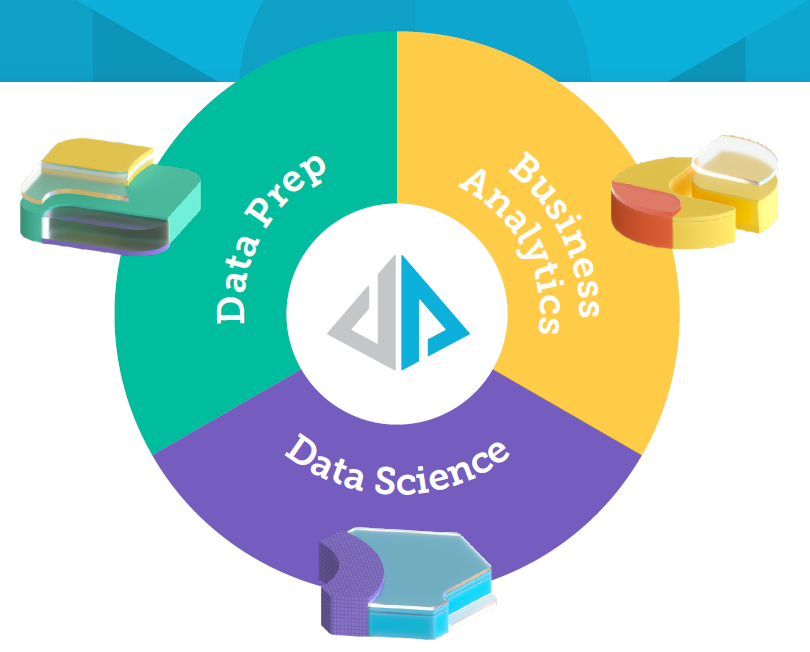
KASH Tech's Approach to Choosing the Right Technology Platform
At KASH Tech, we believe in taking a vendor-agnostic approach to building our client's data and analytics strategies. Rather than focusing on selling a specific software or platform, we approach data and analytics strategies holistically. This means we will evaluate your business's unique needs to advise on the best tool or platform for your specific needs and audience.
We follow a systematic approach to addressing the requirements of our clients when it comes to digital transformation challenges by employing a four-phase process that ensures each client receives a custom solution tailored to their unique configuration.
The methodology involves a thorough analysis that provides a comprehensive strategy for successful implementation. If you want to learn how to unlock advanced business intelligence, eliminate data silos, and create actionable business insights, download KASH Tech's Advanced Analytics Playbook eBook for free. It's a valuable resource for organizations wanting breakthrough business insights.
If you’re ready to explore solutions, request a data and analytics discovery call from the KASH Tech team.
